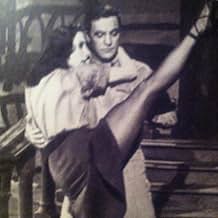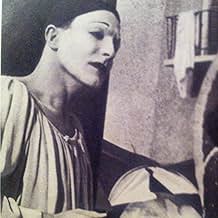VALUTAZIONE IMDb
6,4/10
1092
LA TUA VALUTAZIONE
Aggiungi una trama nella tua linguaThree different stories are told through a notably unusual way - no words, just dance.Three different stories are told through a notably unusual way - no words, just dance.Three different stories are told through a notably unusual way - no words, just dance.
- Regia
- Sceneggiatura
- Star
- Premi
- 1 vittoria e 1 candidatura in totale
Luigi Faccuito
- Specialty Dancer
- (non citato nei titoli originali)
Diki Lerner
- Thief in 'Sinbad the Sailor'
- (non citato nei titoli originali)
Paddy Stone
- Speciality Dancer
- (non citato nei titoli originali)
Ian Wilson
- Man Exiting Stage Door in 'Ring Around the Rosy'
- (non citato nei titoli originali)
Recensioni in evidenza
Gene Kelly was a visionary. He was passionate about his art and he was a master.
If you are passionate about your art and creativity, you will enjoy this celebration of dance. There is no dialogue to explain what is happening. There is no person telling you what to think. Kelly brings you to a moment and allows you to make the most of it.
Did you see love, pain, joy, desire, frustration, anger...congratulations!
If you are passionate about your art and creativity, you will enjoy this celebration of dance. There is no dialogue to explain what is happening. There is no person telling you what to think. Kelly brings you to a moment and allows you to make the most of it.
Did you see love, pain, joy, desire, frustration, anger...congratulations!
This film includes three dance interpreted stories, choreographed and starring the great Gene Kelly. The first story is called "Circus" which tells the story of a circus clown who is secretly in love with the Circus Ballet Star who is openly in love with the Circus High-Wire-Walker. The second story is called "Ring Around The Rosy" which tells the story of a bracelet that is past from one silly lover to the next. The third story is called "Sinbad The Sailor" which tells the story of a navy sailor who, while on shore leave in Bagdad, finds a magic lamp that takes him on an animated adventure.
Each story includes an all star cast of "then" well known dancers who give outstanding performances that only Gene Kelly fans and other dancers could appreciate. It is a delightful film, that will brighten any persons video library.
Each story includes an all star cast of "then" well known dancers who give outstanding performances that only Gene Kelly fans and other dancers could appreciate. It is a delightful film, that will brighten any persons video library.
Invitation To The Dance took three years to make and it was a labor of love for Gene Kelly. Too bad for him that the public didn't take to it. But it was a film aimed at a highly specialized audience, those lovers of the ballet and other forms of dance.
Around the time that Kelly was winning plaudits for Singing In The Rain he pitched the idea to the MGM studio heads and having just starring in a film that many claim as the greatest musical ever made, he was in a position of considerable leverage. To cheapen costs MGM shot it over in the United Kingdom and this does explain Kelly's appearance in a pair of British films, Crest Of The Wave and The Devil Makes Three while putting together his dance film.
All this is according to the Citadel Film series book on Gene Kelly's films and then because the third and the best sequence was to be done with animated figures like Kelly's famous dance number with Jerry Mouse in Anchors Aweigh, MGM wanted to use Hanna&Barbera their crack cartoonists. Which meant him coming back to the USA to shoot that sequence. All in all it wasn't until 1956 that Invitation To The Dance finally made it before audiences.
The story I found most astounding was Andre Previn who was brought in to score the second sequence about a piece of jewelry making the rounds. MGM didn't like the original score, but the sequence had already been shot. So Previn had to score a ballet which had already been shot with another man's music. No small feat indeed and more production delays.
All this for what was really a film that should have had limited art house release. But MGM didn't do art house type films and they wanted their money back some how.
The three sequences all have Kelly in them, MGM would have it no other way. The first casts Kelly as a Pagliacci type clown in a circus dance drama. The second is as I described before. The third has Kelly as a sailor who gets a magic lamp and a genie appears. It is the best of them.
I'm sure Gene Kelly was disappointed in the lack of applause from a mass audience for Invitation To The Dance. It's a good film, but definitely for a special audience.
Around the time that Kelly was winning plaudits for Singing In The Rain he pitched the idea to the MGM studio heads and having just starring in a film that many claim as the greatest musical ever made, he was in a position of considerable leverage. To cheapen costs MGM shot it over in the United Kingdom and this does explain Kelly's appearance in a pair of British films, Crest Of The Wave and The Devil Makes Three while putting together his dance film.
All this is according to the Citadel Film series book on Gene Kelly's films and then because the third and the best sequence was to be done with animated figures like Kelly's famous dance number with Jerry Mouse in Anchors Aweigh, MGM wanted to use Hanna&Barbera their crack cartoonists. Which meant him coming back to the USA to shoot that sequence. All in all it wasn't until 1956 that Invitation To The Dance finally made it before audiences.
The story I found most astounding was Andre Previn who was brought in to score the second sequence about a piece of jewelry making the rounds. MGM didn't like the original score, but the sequence had already been shot. So Previn had to score a ballet which had already been shot with another man's music. No small feat indeed and more production delays.
All this for what was really a film that should have had limited art house release. But MGM didn't do art house type films and they wanted their money back some how.
The three sequences all have Kelly in them, MGM would have it no other way. The first casts Kelly as a Pagliacci type clown in a circus dance drama. The second is as I described before. The third has Kelly as a sailor who gets a magic lamp and a genie appears. It is the best of them.
I'm sure Gene Kelly was disappointed in the lack of applause from a mass audience for Invitation To The Dance. It's a good film, but definitely for a special audience.
No wonder INVITATION TO THE DANCE found no audience at the box office. The first two musical sequences, "Circus" and "Ring Around the Rosy" are monumental bores dragged down by pedestrian stories and, in the second one, inept use of camera trickery to speed up the action.
But the third, "Sinbad the Sailor," makes expert use of the Rimsky-Korsakov ballet score and makes dazzling use of animated effects, especially for the dancing between Kelly and a couple of Arabian guards which are highly original, intricate and amusing examples of combining live action with animation. It's the kind of originality sadly missing in the previously mentioned stories.
The "Sinbad" highlight almost makes up for the rest of the film with its own brand of originality--but alas, the first two sequences are enough to turn many viewers away from watching the final segment.
Summing up: Easy to see why this one failed miserably to attract a target audience with either high or low brow tastes.
But the third, "Sinbad the Sailor," makes expert use of the Rimsky-Korsakov ballet score and makes dazzling use of animated effects, especially for the dancing between Kelly and a couple of Arabian guards which are highly original, intricate and amusing examples of combining live action with animation. It's the kind of originality sadly missing in the previously mentioned stories.
The "Sinbad" highlight almost makes up for the rest of the film with its own brand of originality--but alas, the first two sequences are enough to turn many viewers away from watching the final segment.
Summing up: Easy to see why this one failed miserably to attract a target audience with either high or low brow tastes.
It might better have been called "Invitation to the Pantomime" because there is no speaking, much less singing, in the film, a production much better suited to the stage. The movie does in fact look like a filmed stage production, and the format and ambitions of the film are not what audiences had come to expect from Gene Kelly. But this was his baby, and he wanted to take filmed dance to entirely new levels of artistic achievement. In many ways, it is a testimony to his power as a choreographer and a star that he was able to pull it off. Nevertheless, beautiful as it is, this is not everyone's cup of tea. Watching the first of the three dance sequences, I longed for Kelly to take that white paint off his mime face and stop mooning over the ballerina. He did, and the next two sequences are more enjoyable, the last being rather fun when animation takes over. ---from Musicals on the Silver Screen, American Library Association, 2013
Lo sapevi?
- QuizGene Kelly's original intention was to make a film that would educate mainstream audiences about professional dancing in the world. To this end, he wanted to cast the greatest dancers in Europe for the four segments in leading roles. He himself would appear in only one - the Popular Song sequence, which ended up being cut. MGM, however, refused to allow the picture unless he appeared in all of them. Many of the professionals who worked in the film agreed that this was one of the film's great weaknesses.
- BlooperDuring the "Scheherazade" sequence, the color of the palace guard's costume changes from green to blue.
- ConnessioniEdited into American Masters: Gene Kelly: Anatomy of a Dancer (2002)
- Colonne sonoreCircus
Music by Jacques Ibert
Performed by The Royal Philharmonic Orchestra, conducted by John Hollingsworth
Danced by Gene Kelly, Igor Youskevitch and Claire Sombert
I più visti
Accedi per valutare e creare un elenco di titoli salvati per ottenere consigli personalizzati
- How long is Invitation to the Dance?Powered by Alexa
Dettagli
Botteghino
- Budget
- 1.500.000 USD (previsto)
- Tempo di esecuzione1 ora 33 minuti
- Proporzioni
- 1.37 : 1
Contribuisci a questa pagina
Suggerisci una modifica o aggiungi i contenuti mancanti

Divario superiore
By what name was Trittico d'amore (1956) officially released in India in English?
Rispondi































